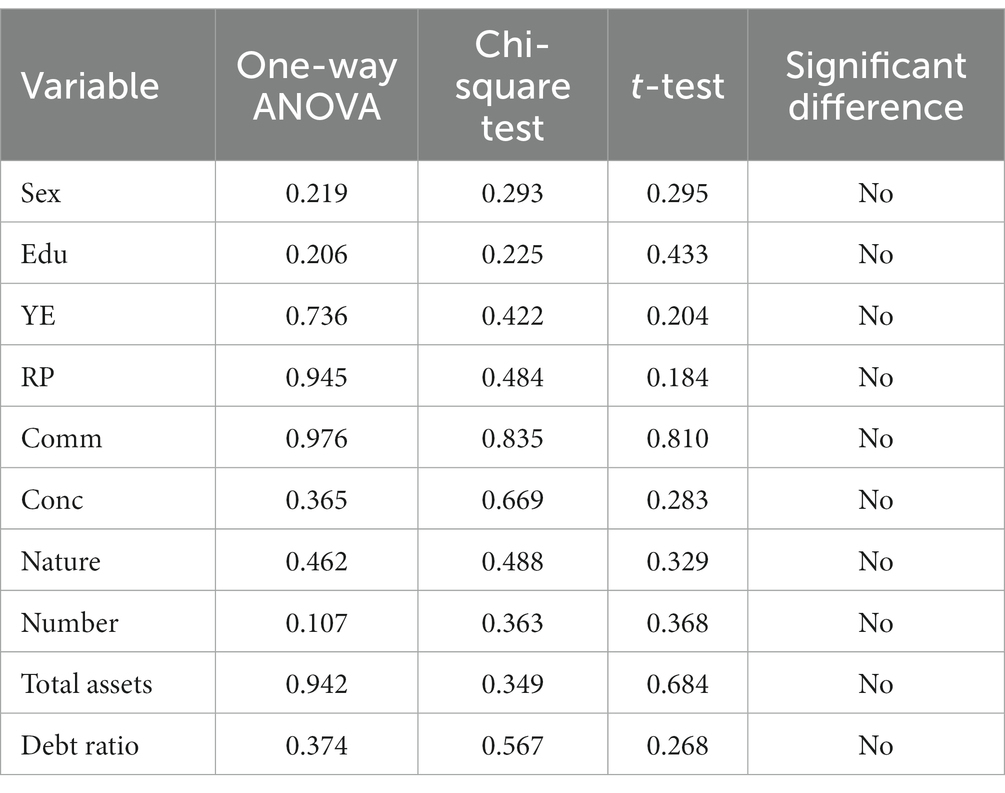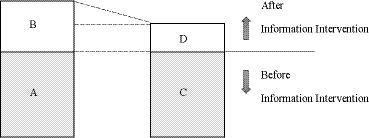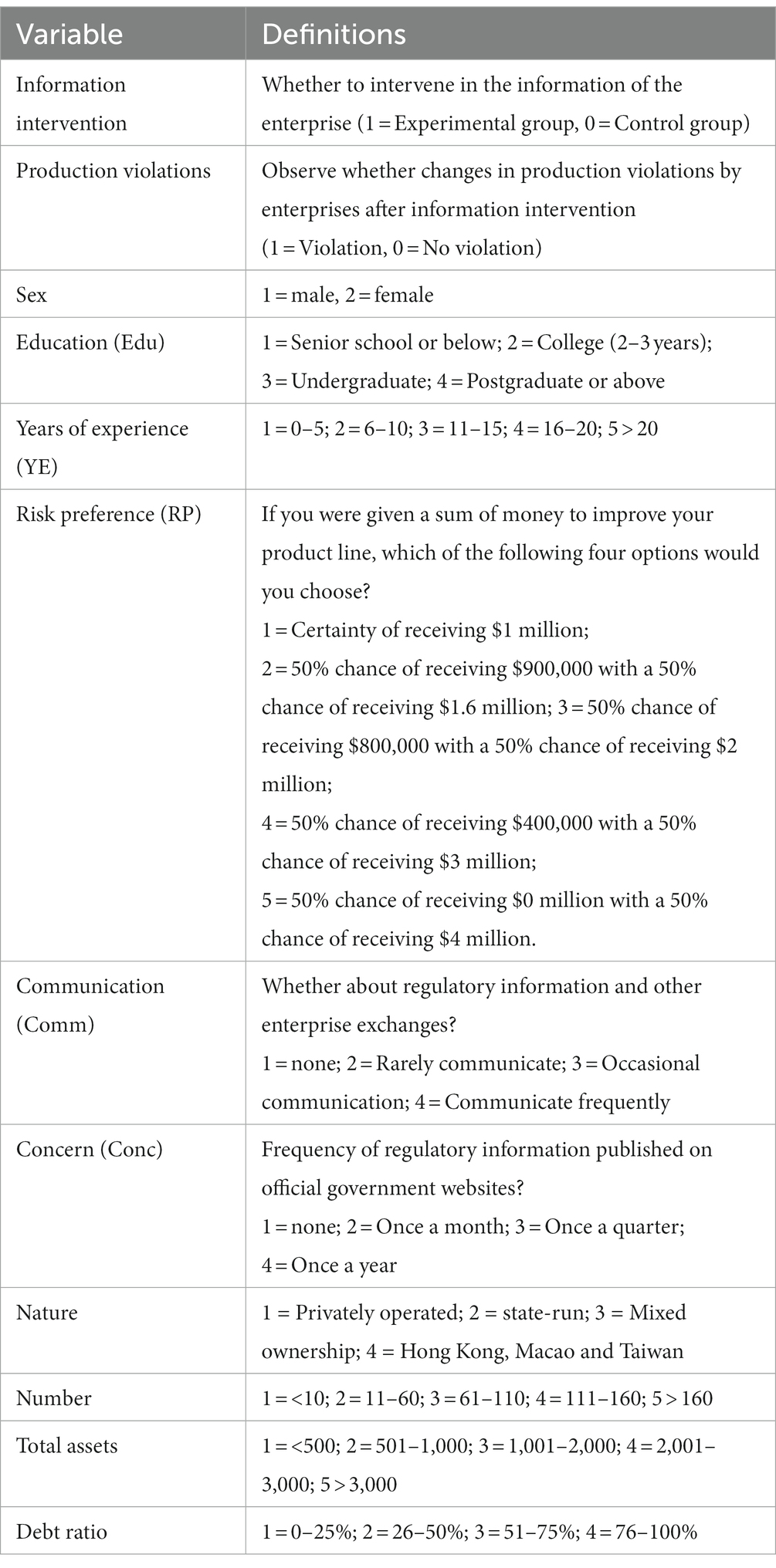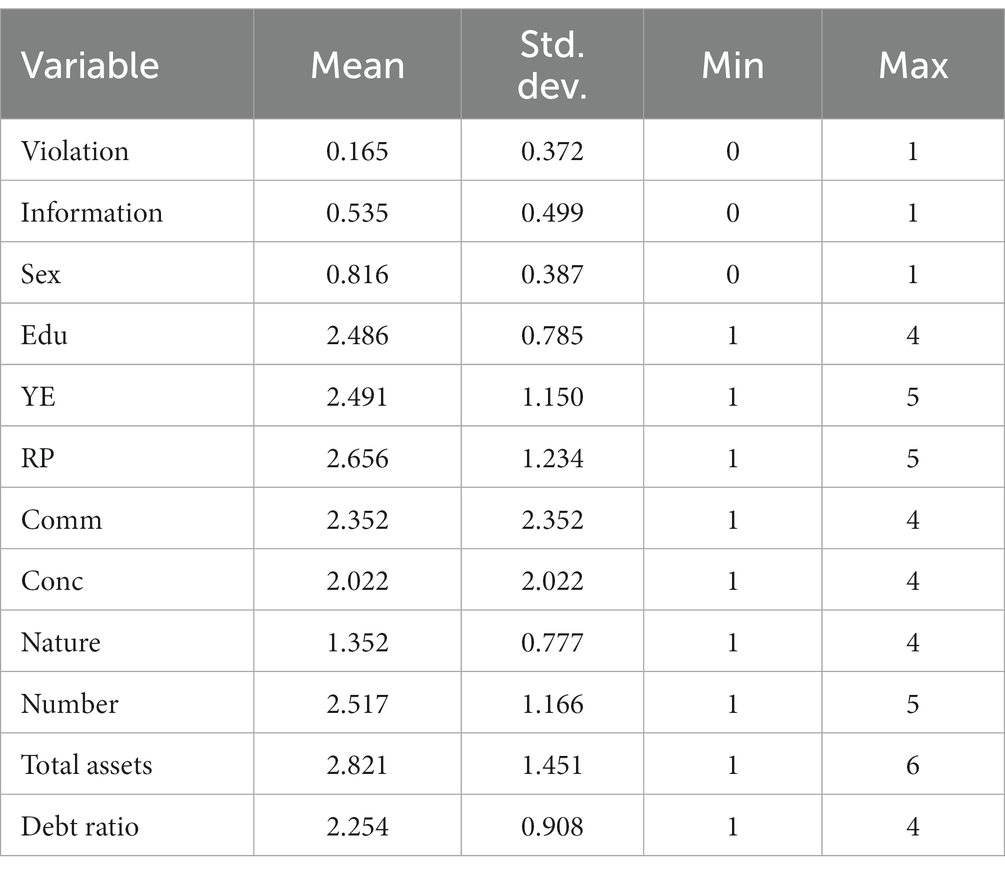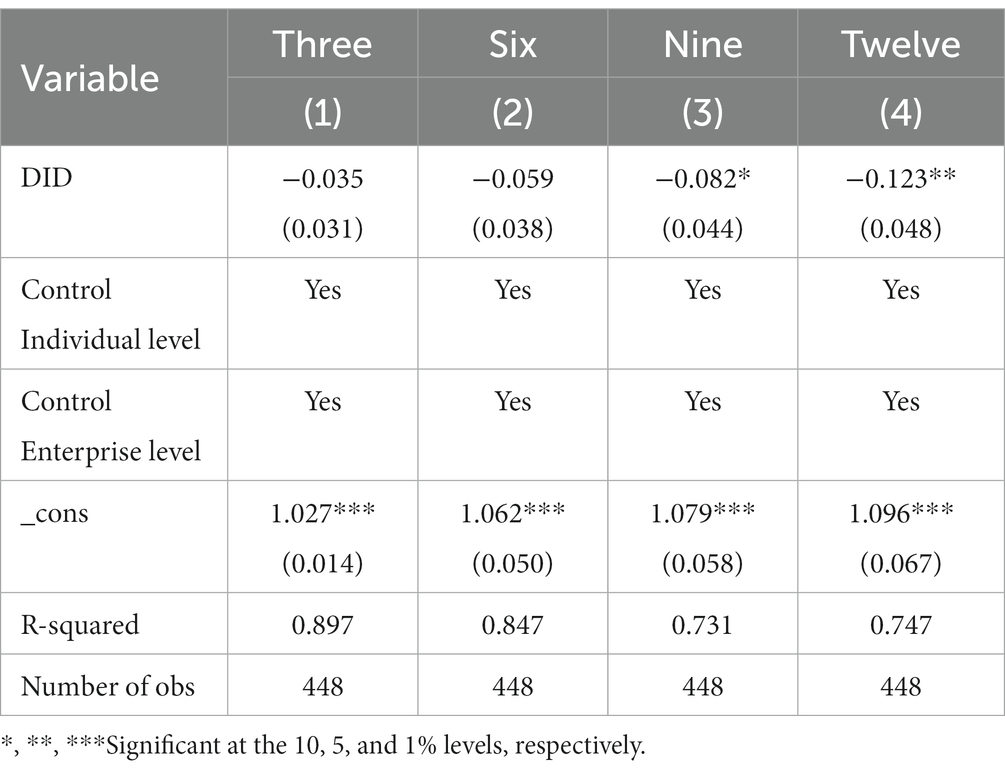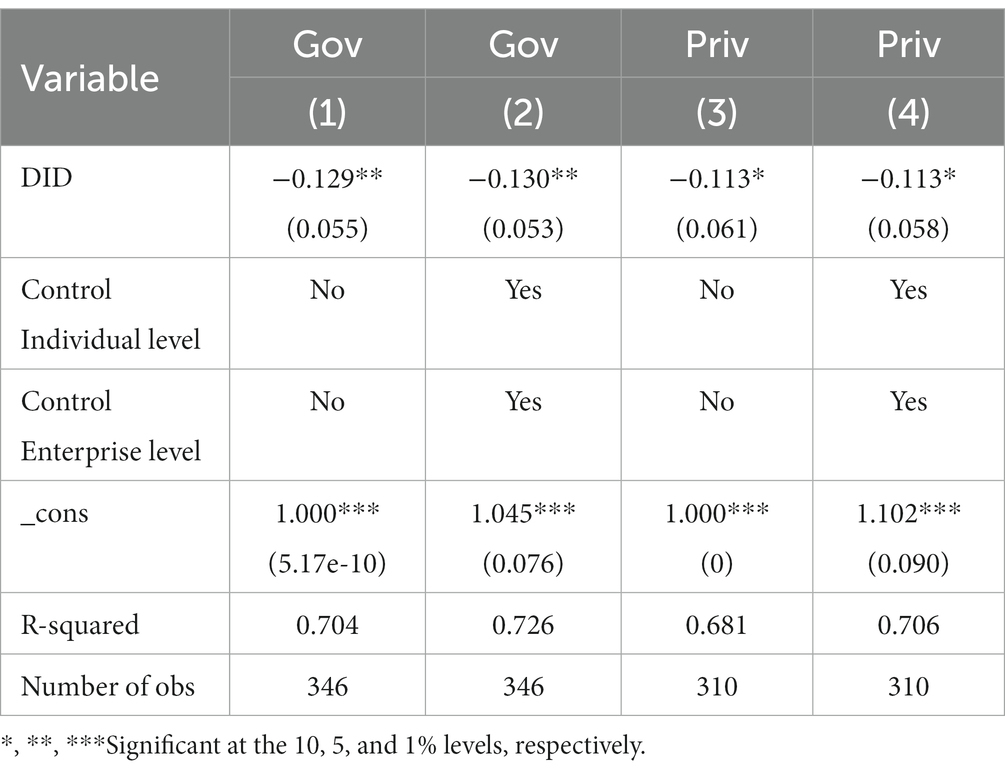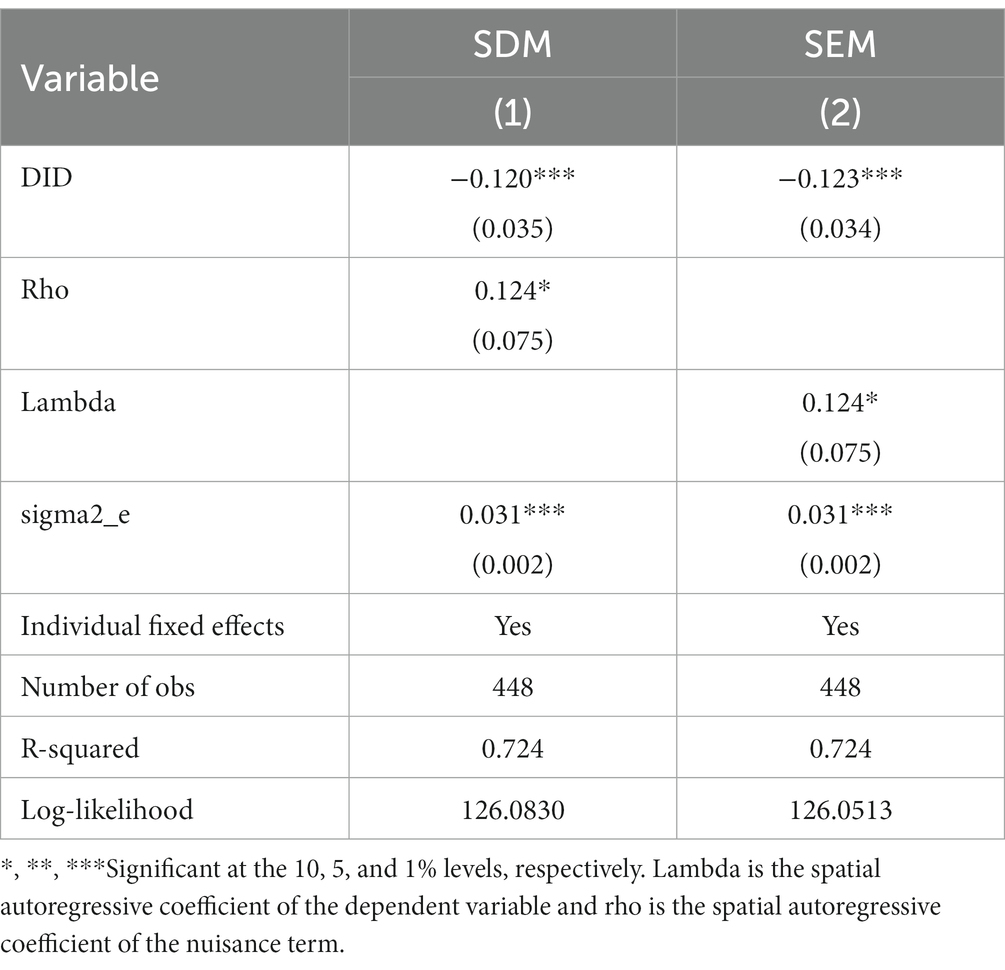- 1College of Economics and Management, Nanjing Agricultural University, Nanjing, Jiangsu, China
- 2College of Business Administration, Anhui University of Finance and Economics, Bengbu, Anhui, China
The prevalence of unsafe food poses a widespread challenge across numerous nations. Despite the continuous investments by the Chinese government in food safety regulation, the condition of food safety in China is still not ideal and requires substantial enhancements. Cost-effective, information-based strategies are essential for the effective management of food safety hazards. In this research, we established an extensive database of food enterprises with documented violations and carried out a randomized intervention trial to assess the effects of regulatory information interventions on the decrease of production violations in these enterprises. The findings reveal that interventions based on food safety regulatory information were instrumental in diminishing production violations among food enterprises and had spillover effects within a given geographic area. It is important to note that the impact of the intervention was delayed, with noticeable results on production violations becoming apparent 6 months post-intervention. Additionally, the degree of information communication and the degree of information concern can positively moderate the reduction of food enterprises’ production violation behavior by food safety regulatory information intervention.
1 Introduction
Information asymmetry between food suppliers and consumers regarding the quality of food safety is a significant contributing factor to food safety issues (McCluskey, 2000; Stiglitz, 2002). Food products possess inherent characteristics of trust goods, making it challenging for consumers to accurately assess product quality even after consumption (Dulleck et al., 2011). In the domain of public safety governance, the government, acting as a representative of consumers, assumes a crucial role (Song et al., 2020). In the context of increasingly intricate food supply chains, regulators and producers encounter substantial information asymmetry concerning the quality of food safety, which is a shared challenge faced by regulators worldwide. Enhancing the probability of detecting problematic food items is essential for effective control of food safety risks. Notably, both China and the United States, as the world’s largest economies, have made progressive investments in food safety regulations (Jin et al., 2021). In 2021, the U.S. Food Safety and Inspection Service (FSIS) allocated $1.421 billion for food safety inspections (USDA, 2021). Similarly, China’s State Administration for Market Regulation (SAMR) invested $2.689 billion in food safety regulations in 2021 (SAMR, 2022). These investments primarily target food testing costs associated with sampling and inspection, food procurement expenses, and the allocation of human and financial resources (Zhou et al., 2020).
Regulators have been employing food safety sampling efforts to elevate the probability of detecting problem foods and penalties to raise the cost of violations by problem enterprises, which is a common regulatory tool for global food safety risk control by regulators, and China is no exception (Johnson, 2020). For the severity of penalties, the Food Safety Law, revised by the Chinese government in 2015, has been described as “the strictest ever.” From the changes in the Food Safety Law in 2009 and 2015, the penalties for enterprises that produce substandard food (i.e., production violation enterprises) are as follows: the lower limit of fines for the production and operation of food and food additives contaminated by packaging materials, means of transport, and containers was increased from US$284 to US$711, 2.5 times higher than the original limit. Production and operation of pesticide and veterinary drug residues, microbial contamination, and other substances hazardous to human health exceeded the lower limit of fines from $284 to $7,111, 25 times the original. The addition of substances hazardous to human health, operating sick and dead, poisoned animal meat, and meat inspection and quarantine cases of an unqualified lower limit of fines was increased from $284 to $14,223, soaring to 50 times the original.
For the Chinese government’s intensity of food safety sampling, the number of batches of food safety sampling in China reached 6,954,400 in 2021, with the intensity of sampling reaching an average of 4.92 batches per 1,000 people per year and the respective food producer being sampled an average of 17.93 times per year. However, the food safety situation in China has not improved (Li et al., 2023). As revealed by our examination of the data on violating enterprises disclosed by China’s State Administration of Market Regulation (SAMR), numerous Chinese provinces have a high proportion of producers with recurrent food quality problems. For instance, in Anhui Province, China, the percentage of producers with recurrent food quality problems in 2019 was 59.4%. It can be seen that simply increasing supervision did not significantly reduce the production violations of food enterprises.
Although the Chinese government has invested more regulatory resources in food safety sampling, food producers’ perception of government regulatory efforts is not evident (An, 2020; Fan, 2021). Due to the apparent distribution characteristics of food products, the potential for unsafe food arises during packaging, transportation, and storage processes. Consequently, market regulators primarily focus their sampling and inspection efforts on the distribution chain, specifically targeting distributors (Jin et al., 2021; Zhou et al., 2022). China’s market supervision and administration system operate at four levels: national, provincial, municipal, and county. Sampling frequency typically ranges from 1 to 2 times per week. The data obtained from sampling are directly recorded in the platform of China’s State Administration of Market Regulation (SAMR). Non-compliant food batches are traced back to the food production enterprises and subjected to punitive actions by the respective territorial regulatory authorities. However, information regarding qualified food batches is not communicated to the producers. The distributive character of food determines that the local market supervision authorities only carry out sampling inspections on food products sold in the region, not on the production enterprises. The Local market supervision authorities lack comprehensive knowledge of the sampled batches from each food production enterprise within their jurisdictions, thus relieving SAMR from the obligation of requiring accurate disclosures to enterprises. Consequently, apart from the SAMR, only distributors possess this sampling information. However, distributors are burdened with the task of investing significant time and effort into calculating the number of samples for each food production enterprise. In a multi-level distributor food supply chain, it is even more difficult to transfer information effectively (Fei and Wang, 2016). As a result, food production enterprises can only grasp the number of food sampling batches for which they have been penalized without knowing the total number of batches for which they have been sampled. Furthermore, the intensity of sampling and punishment of each food production enterprise by the regulator is different, and it is difficult for enterprises to figure out the intensity of sampling and punishment in the industry and region.
Under the downturn of the global economy, the constraint of regulatory resources turns out to be a vital issue to be urgently addressed by the regulators of various countries. Information, a low-cost regulatory tool, has been generally employed in developed countries. However, from the perspective of practical policies of China’s food safety regulation, the existing policy focus and relevant research focus on sampling inspection of food safety, whereas information tools have been rarely employed (Zhou et al., 2022). The Chinese government is aware of this. To tackle down the problem of asymmetric government regulation information in the food supply chain, the Chinese government has established the food safety information disclosure system. Market regulators will employ the respective period of food sampling and unqualified information on its official website to achieve the effect of information disclosure for deterring enterprises. However, since the content of the food safety regulatory information disclosed on the official website does not present any vital information regarding enterprises’ concerns, such as the frequency of enterprises being sampled and the intensity of local government regulation, coupled with the cumbersome operation and insufficient publicity, enterprises’ utilization of the food safety regulatory information released on the official website is low (An, 2020; Zhou et al., 2020; Yang and Wu, 2022). As indicated by the research team’s studies in Shandong and Henan provinces in China, most food production enterprises only acquire information regarding their punishments, and they are not aware of the actual number of times the government sampled their enterprises, nor are they aware of the intensity of regulation in the region and the intensity of other enterprises being regulated, which provides a realistic basis for this study to reduce enterprise production violations through information interventions. The information regarding the strength of local government regulation and industry regulatory efforts was disclosed by compiling a food safety regulation information report, and whether the enterprises have ceased their production violations in the following year was observed to provide feasible support for the government to manage food safety problems through information tools.
This study makes valuable contributions to the existing literature in several significant aspects. Firstly, it identifies the prevalence of recurrent production violations among food enterprises as a key factor hindering the improvement of food safety in China. Importantly, the study highlights the feasibility of employing information tools to address the issue of repeated production violations in food enterprises, an aspect that has received limited attention in prior research. The findings underscore the substantial efficacy of food safety regulatory information interventions in significantly reducing production violations within food enterprises, while also generating noteworthy spillover effects within specific geographic intervals. These findings offer valuable insights to guide governmental decision-making in managing food safety concerns through the utilization of information tools. Secondly, the study employs a rigorous randomized intervention experiment conducted in a real-world setting. As previously mentioned, each food production enterprise was sampled an average of 17.93 times in 2021. The availability of publicly disclosed food safety sampling data from the Chinese SAMR provides robust empirical support for assessing the production violations of food enterprises.
2 Related research and theoretical basis
Information asymmetry has been reported as a critical cause of the opportunistic behavior of food producers (Akerlof, 1970; McCluskey, 2000). Solving the information asymmetry problem requires effective regulation by regulators and institutional arrangements by organizations (Zhou et al., 2022). In general, existing regulatory instruments on food producers comprise administrative, which covers food safety sampling efforts (Jin et al., 2021), institutional arrangements for food safety sampling (Kong et al., 2019; Li, 2020), and penalties for substandard food products (Yu et al., 2023), as well as the implementation of a recall system for substandard products (Sohn and Oh, 2014; Zhang, 2015).
Information tools are another important instrument used by market regulators to manage food safety issues (Dranove and Jin, 2010). Research on the effect of information disclosure on individual decision-making has been well documented, but the above-mentioned studies have mainly focused on education, health care, and finance. Food and food services research is very limited (Zhou et al., 2011). Jin and Leslie (2003) showed that a quality rating card policy in Los Angeles, USA, not only significantly improved the hygienic quality of restaurants but also increased consumer sensitivity to food safety. Ollinger and Bovay (2020) showed that both credible threats and actual government action to disclose the quality and safety of chicken meat publicly could motivate chicken slaughterhouses to improve quality and safety. Using data from fish wholesaling in three Chinese provinces, Zhou et al. (2022) analyzed the positive effect exerted by a policy combination of food safety sampling intensity and information disclosure on supply chain traceability adoption. Furthermore, several research studies have highlighted that the evaluation and certification of sellers by marketplaces (Elfenbein et al., 2015) and the promotion of product labeling (Westgren, 1999; Kafetzopoulos et al., 2013) can facilitate the adoption of quality and safety management practices by product suppliers.
Information interventions and disclosures are both information tools, but they differ significantly. Information disclosure aims at publicizing relevant information to examine the decision-making behavior of relevant subjects, such that individuals are required to receive information and make adjustments actively. Besides, information intervention employs intervention to make the relevant subjects passively accept information. As revealed by a considerable amount of research using behavioral experiments with information interventions in health medicine, child development, consumer behavior, and farmer decision-making, information interventions can notably improve individual behavioral decisions (Hoelscher et al., 2002; Abrahamse et al., 2005; Fischer, 2008; Karlin et al., 2015; Young et al., 2017).
Enterprises need to make decisions based on information. Enterprise decision-making is a process of information flow and conversion. Accordingly, the effective transmission of government regulatory information is the basis for food enterprises to adjust their production behavior. The “nudge theory” provides the theoretical basis for this study. The original meaning of the word “nudge” in English is “to nudge someone to get their attention” (Thaler and Sunstein, 2008). Nudging aims at changing people’s behavior and how they choose and intervene in the choice system, placing stress on the need to make better choices while maintaining or increasing freedom (Hausman and Welch, 2010; Halpern, 2015).
Enterprises aim at maximizing profits, and higher returns from violations are the endogenous motivation for enterprises to choose to violate production practices. Although the Chinese government has enhanced its regulatory efforts, food production enterprises have not gained more insights into the strength of government regulation due to information asymmetry, and their underestimation of the expected costs of violation is an important reason why they continue to violate production. The facilitative role played by information interventions aims to affect the choice structure orientation of people’s behavior in a predictable direction without using prohibitions or obvious economic incentives. The information report on food safety regulations prepared for the study conforms to interviews with food production enterprises, and this study suggested that the above-described information can help enterprises make the right choices.
3 Materials and methods
3.1 Research designs and models
This study employed a randomized intervention experiment to empirically examine the impact of food safety regulatory information interventions on production violations within food enterprises. As previously mentioned, food enterprises encounter two main challenges regarding the acquisition of food safety regulatory information. Firstly, the efficiency of information delivery is low, and secondly, the information content does not align with the specific needs of food enterprises. Consequently, the existing food safety regulatory information fails to effectively deter non-compliance among food enterprises. To address this, the study collected and synthesized publicly disclosed food safety regulatory information from market regulatory authorities in each province across China. Subsequently, a comprehensive food safety regulatory information report was generated (Supplementary Appendix 1). The content of this report was determined through interviews conducted with two market supervision personnel and 10 decision-makers from food enterprises. The report encompassed various specific elements, including national food safety regulatory policies and information, local government regulatory information, enterprise-specific regulatory information, rankings of regulatory compliance among enterprises, regulatory information pertaining to surrounding enterprises, industry-specific hazard type information, and industry regulatory information.
The study employed a random assignment strategy to divide the obtained sample into two distinct groups. The experimental group consisted of food enterprises that received customized information reports pertaining to food safety regulations specifically tailored for their respective enterprises. Conversely, the control group did not receive any intervention or modifications to their existing practices. Through this process, 120 food enterprises were randomly selected as the intervention group, while 104 enterprises were assigned to the control group. Following the balance test, which assessed the comparability of the two groups, no statistically significant differences were observed, as indicated in Table 1. The information intervention took place between January and May 2022. We collaborated with local market regulators, who provided us with the contact information of each food business. Subsequently, we communicated with each food business via phone calls after sending the food safety regulatory information reports to their respective email addresses. This ensured that every food business received and had access to the provided information.
The research conducted in this paper spanned a period of 1 year. By examining the food safety sampling databases of various provinces in China, the study obtained data on production violations committed by food enterprises in the subsequent year. As previously mentioned, the average number of sampling inspections per food enterprise in 2021 was 17.93, ensuring that every food enterprise would be subject to sampling. By comparing the occurrence of production violations between the experimental group and the control group in the subsequent year, we can ascertain the impact of the food safety regulatory information intervention on reducing production violations within the enterprises.
The study utilizes a difference-in-differences model to examine the impact of food safety regulatory information intervention on reducing violation production behavior within food enterprises. The underlying principle of the difference-in-differences model is illustrated in Figure 1, where Group A represents the experimental group and Group C represents the control group. Prior to the intervention, Groups A and C are assessed to ensure no statistically significant differences exist between them, establishing comparability and creating a counterfactual sample. If an intervention had been applied to Group A, it would have led to an increase denoted by B. In the absence of any intervention for Group C, a natural change denoted by D would have occurred. In reality, B comprises both the effect of the intervention and the component of natural growth. Due to the lack of significant differences between Groups A and C before the intervention, D also represents a statistically significant element as part of the natural change in Group A. Consequently, the difference between B and D represents the net effect of the intervention.
The specific model steps are elucidated in the following: A difference-in-differences model (DID) was built. First, the dummy variable is divided in accordance with whether the information intervention is experienced, for the experimental group of violating enterprises, and for the control group of violating enterprises. Subsequently, the pre and post information intervention is divided into two parts, which are denoted by , where and denote the pre and post information interventions of the violating enterprises, respectively. denotes the change in production violations for enterprise at time , and denotes the change in production violations for enterprise after . Among them, and denote the change of production violation in the treatment and control groups at two times, respectively. According to the definition of the multiplicative difference method, the change difference in the efficiency of food enterprises to reduce their production practices in violation after experiencing information intervention is expressed as:
Where denotes the “counterfactual” in the proposed natural experiment framework. It is noteworthy that the difference in the change of the control group before and after the information intervention is a reasonable proxy, i.e., assuming that , Eq. (1) can be transformed into . Following the basic setting of the multiplicative difference method, the econometric model is written as:
In Equation (2), δ denotes the actual difference of the change in production violation of enterprise reduction after information intervention; represents the control variable; denotes the error term.
3.2 Data
The data used in this study are derived from two distinct sources. Firstly, information on production violations committed by food enterprises is obtained from publicly available food safety sampling data published by the Market Supervision Administration across various provinces in China. Secondly, the baseline data pertaining to food enterprises are collected by the research team between January 2022 and May 2023 from multiple regions within China, including Shandong Province, Henan Province, Anhui Province, Chongqing Municipality, and Xinjiang Uygur Autonomous Region. Due to the challenges associated with acquiring comprehensive baseline data on food enterprises, the final sample size of 224 food enterprises with a history of non-compliance was obtained, satisfying the statistical requirements of the study.
In this study, a structured questionnaire design was adopted, which contained two main aspects, i.e., the characteristics of enterprise decision-makers and enterprise characteristics. The characteristics of enterprise decision-makers included gender, age, years of experience, risk preference, the degree of information communication, and the degree of information concern. The characteristics of enterprises comprised their nature, number, total assets, and debt ratio.
Table 2 lists the respective variable and its definition in the empirical analysis of this study.
3.3 Variables and descriptive statistics
Table 3 presents a descriptive statistical analysis of the data required for the empirical analysis. From the perspective of data statistics of information intervention, 53.5% of enterprises were assigned to the processing group, and 46.5% were assigned to the control group. Little difference exists between the two groups of data. From the perspective of the dependent variable of the sample, nearly 16.5% of the violating enterprises repeated production violations after information intervention, suggesting that 84.5% of the violating enterprises did not have repeated production violations. In subsequent analyses, the policy effects of information intervention are illustrated.
4 Empirical results
4.1 Balance test
The objects of information intervention in this study were randomly selected. To show the unbiased selection of samples, the experimental group and the control group were tested for balance. Table 1 shows the results of one-way ANOVA, Chi-square test and t-test. As revealed by the results, under the three test methods, all control variables were not significant (p > 0.1), suggesting the balance between the experimental and control groups in the study and providing unbiased data support for the different-difference method adopted.
4.2 Results of the baseline model
Table 4 presents the effects of food safety regulatory information interventions on reducing production violations in food enterprises 12 months post-intervention. To be specific, column (1) of the table lists the DID results without including control variables. Column (2) lists the regression results based on model (1) with the inclusion of enterprise decision-maker characteristics, and column (3) lists the regression results based on model (1) with the inclusion of enterprise characteristics. Column (4) lists the regression results after adding the characteristics of enterprise decision-makers and enterprise characteristics. The DID regression coefficients in columns (1)–(4) are statistically significant at the 5% level, confirming a significant positive impact of food safety regulatory information interventions on reducing production violations within enterprises. Regarding control variables related to decision-maker characteristics, the education level of decision-makers is negatively and significantly correlated with production violations, suggesting that better-educated decision-makers are more effective at reducing violations. Furthermore, the degree of information communication displays a negative and significant correlation with production violations, indicating that a higher frequency of regulatory information communication contributes to a greater likelihood of reducing production violations. The degree of information concern was also significantly negatively associated with production violations, implying that enterprises that frequently viewed such information were more likely to reduce their production violations after the information intervention. On the other hand, the gender, years of experience, and risk preferences of decision-makers do not demonstrate significant correlations with production violation behaviors. Within the control variables of enterprise characteristics, Within the enterprise characteristic control variables, a tendency for correlation exists between enterprise size and production violations, indicating that larger enterprises may be less inclined to reduce violations. Additionally, the enterprise debt ratio exhibits a significant positive correlation with production violations, indicating that enterprises with higher debt ratios are less likely to reduce their production violations. However, no significant correlations are observed between the nature of the enterprise, total assets of the enterprise, and production violations.
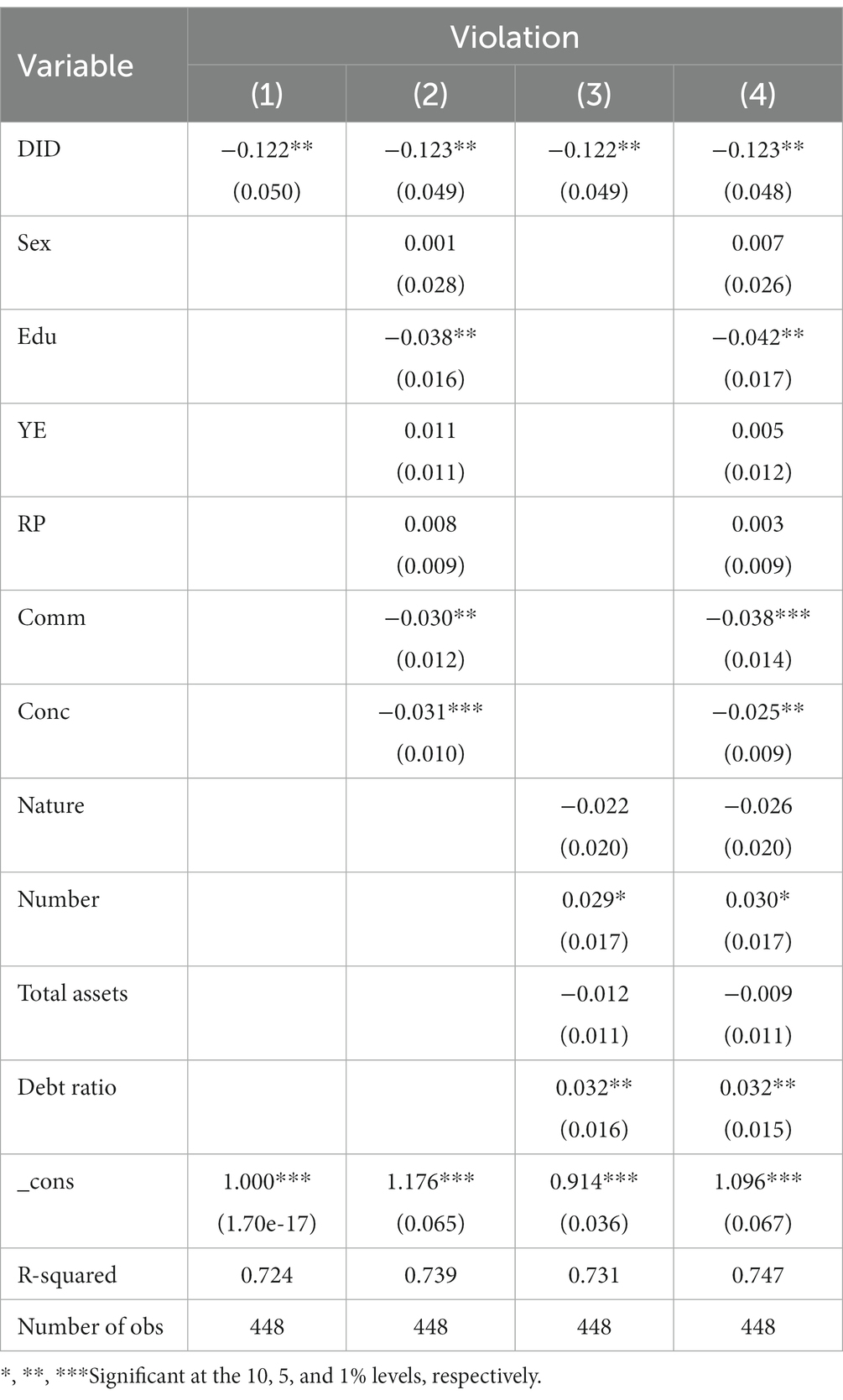
Table 4. The impact of information interventions on reducing production violations in food enterprises.
4.3 Lagged effects of information intervention
The information intervention period was disassembled to observe the Lagged effects of information intervention. Columns (1)–(4) in Table 5 list the reduction effect of food enterprises’ violation production behaviors in 3, 6, 9, and 12 months after information intervention. The DID regression results in columns (1) and (2) were not significant. The DID regression results in column (3) had only a trend toward significance, and those in column (4) were significant at 5%. The DID coefficients of (1)–(4) reached 0.035, 0.059, 0.082, and 0.123, respectively, and the coefficient values tended to be increased. Each model incorporates control variables for the characteristics of the enterprise decision-maker and control variables for the characteristics of the enterprise. The study revealed that food safety regulatory information interventions had a delayed impact on the reduction of enterprise production violations, with a statistically significant trend emerging after a six-month intervention period.
4.4 Heterogeneity analysis of sources of information intervention
Table 6 lists the heterogeneity analysis of information intervention sources. Some of the information interventions in this study were conducted in collaboration with local government market regulators to examine the effect of information sources on the intervention of production violations of food enterprises. In Table 6, columns (1)–(2) show the regression results after food safety regulatory information intervention by way of cooperation between the government and academic institutions of higher education, and columns (3)–(4) show the regression results after food safety regulatory information intervention by academic institutions of higher education. The DID regression results in columns (1)–(2) were significant at 5%, and those in columns (3)–(4) had only a trend toward significance. These findings suggest that university academic institutions collaborating with the government to publish food safety regulatory information reports are more effective in reducing enterprise production violations than university academic institutions operating independently.
4.5 Moderating effects of information communication degree and information concern degree
Table 7 lists the moderating effects of the degree of information communication and degree of information concern on reducing the production violation behavior of food enterprises by food safety regulatory information intervention. The DID*Comm regression results in column (1) had only a trend toward significance, and the DID*Conc regression results in column (2) were significant at 5%, i.e., the degree of information communication and the degree of information concern can positively moderate the reduction of food enterprises’ production violation behavior by food safety regulatory information intervention.
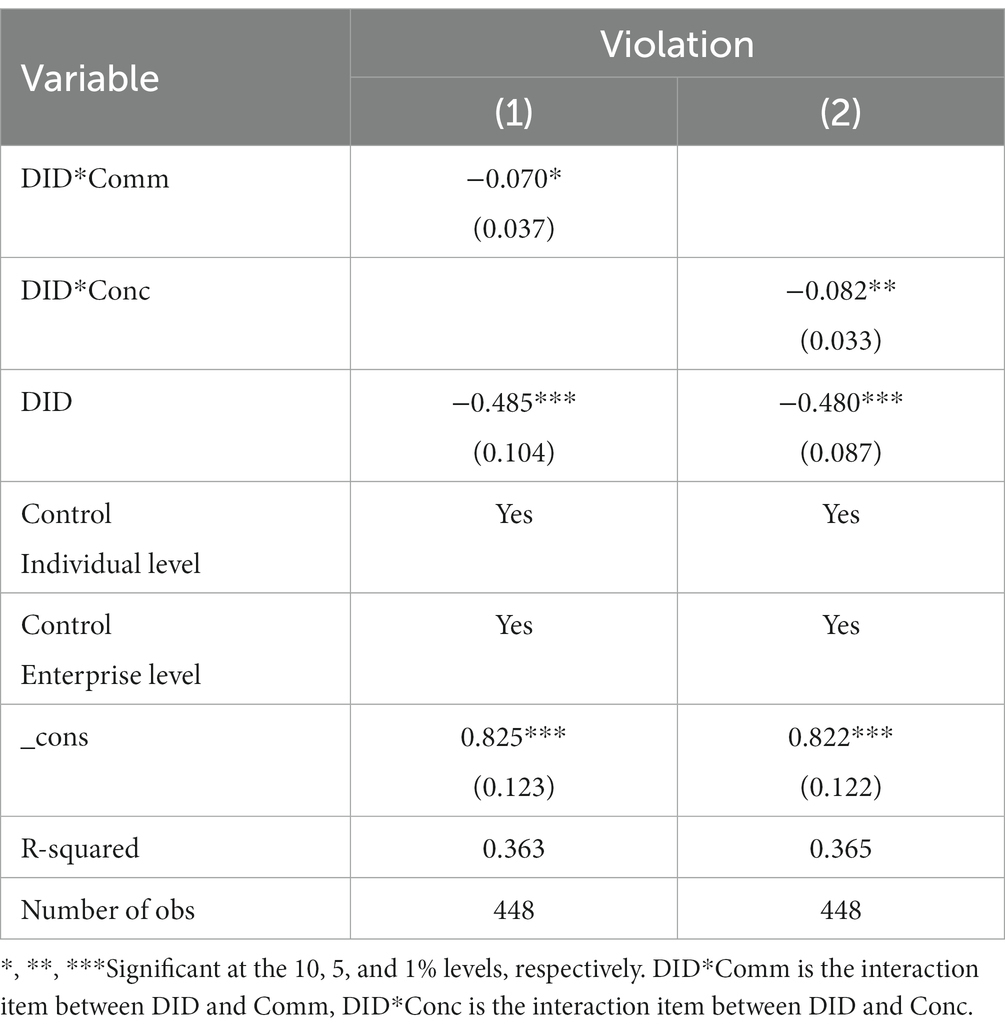
Table 7. Moderating effects of degree of information communication and degree of information concern.
4.6 Spillover effects of information intervention
The study employs a geographical segmentation approach, dividing the 224 food enterprises into 38 regions based on a spatial radius of five kilometers. This segmentation enables the investigation of geographically scaled spillover effects associated with food safety regulatory information interventions on the reduction of production violations within enterprises. In this study, the spillover effects of reduced production violations in food enterprises after the information intervention were examined using the spatial Durbin model (SDM) and spatial error model (SEM). Column (1) in Table 8 lists the spatial Durbin model (SDM) regression results with Rho values showing a trend toward significance, suggesting a positive spillover effect of enterprise production violations on a regional scale after food safety regulatory information intervention, i.e., the reduction of production violations of enterprises will promote the reduction of production violations of other enterprises in the region. Column (2) lists the spatial error model (SEM) regression results, with the lambda values showing a trend toward significance, which also similarly shows the positive spillover effect of reducing production violations within the region.
5 Conclusion
The Chinese government has raised more rigorous regulation a priority for food safety over the past few years, with 172,300 batches sampled in 2015 and 6,954,400 batches by 2021, including an increase of nearly 1 million batches between 2017 and 2018 alone, a growth rate of 42%. However, the Chinese government’s increased food safety regulation has not significantly improved food safety. One crucial phenomenon that was observed in this study was the repeated production violations by Chinese food enterprises. In theory, increased regulation can increase the violation cost, whereas the reality is not as practical as it could be. This phenomenon’s emergence due to information asymmetry was qualitatively explained (Zhou et al., 2020; Jin et al., 2021). Food production enterprises did not perceive the increasing intensity of sampling and inspection as evident and had a cognitive bias about the probability of violations being detected. Accordingly, the corresponding institutional arrangement can be an effective tool to ensure the efficiency of food safety regulation. Information regulation tools play a significant role in food safety regulation as a low-cost regulatory tool, which has become a consensus in the regulatory practice of developed countries.
This study’s findings reveal that interventions based on food safety regulatory information have had a positive impact on diminishing production violations in food enterprises. For each increment in the focus of information-based interventions, the likelihood of an enterprise reducing violations rose by 12 percentage points. The pronounced success of information interventions highlights the significance of information in enterprise decision-making. In the Chinese food supply chain, government regulatory information was inefficiently transmitted between distributors and producers, producers facing severe information constraints had a higher demand for regulatory information, and enterprise decision-making behavior was changed due to information. Regression analysis of control variables showed that with higher educational levels among enterprise decision-makers, information interventions were more effective in curtailing production violations, aligning with conventional wisdom. Conversely, the larger the enterprise, the lesser the impact of information interventions on reducing violations. This study’s information interventions aimed to inform enterprises about the intensity of government oversight and peer regulation, thereby encouraging compliance to avoid hefty penalties for non-compliant products. Larger enterprises may be less influenced by government fines, focusing instead on market-driven consequences and reputational damage from substandard products. For the enterprise debt ratio in the control variables, with the increase in the debt ratio, the enterprises would be less likely to reduce their production violations after the information intervention. Enterprises should invest much capital in improving product quality, and enterprises with high debt ratios were constrained by capital to change this situation. Enterprises were more willing to accept penalties from regulators than to invest in improving their production lines.
Furthermore, the study concluded that food safety regulatory information interventions have a notable delayed effect on the reduction of production violations in food enterprises. Addressing production violations is a systematic endeavor. Interviews conducted by the research team with enterprises that had violations revealed that technical issues, the aging of production line equipment, staff mishandling, procurement of raw materials, and challenges related to packaging, transportation, and storage were the predominant causes of non-compliant products, with the latter four contributing to the majority of issues. Initially, enterprises require substantial time to rectify the aforementioned production challenges. Additionally, with the escalation of government regulation, the probability of non-compliant products being detected increases, necessitating time and resources for enterprises to promptly recall affected products. The study demonstrated that the positive influence on enterprises’ reduction of production violations emerged 6 months following the information intervention and exhibited a significant increasing trend thereafter.
To examine the heterogeneity of different sources of an information intervention on the reduction of production violations of food enterprises, two forms of information intervention were designed for food enterprises in the form of cooperation between university institutions and government and information intervention for food enterprises in the form of university institutions. As indicated by the results of this study, the information intervention in cooperation between university institutions and the government was more effective in reducing the production behavior of food enterprises in violation than that of university institutions. As a regulator, the government was the most trusted source of information for enterprises. However, the influence of the administrative order of the government information intervention on the reduction of the violation production behavior of food enterprises cannot be excluded.
In this study, the moderating role of the degree of information communication between food enterprises and the degree of concern to regulatory information in reducing enterprises’ production violations through information intervention was also examined. The degree of information communication among food enterprises regarding regulatory information took on critical significance in enterprises to clarify the strength of government regulation. In addition, the current information disclosure system established by the Chinese government published information regarding food sampling and penalties in the respective issue on official websites. Although food enterprises cannot grasp the exact level of government regulation through the browsing of this information, enterprises paid more attention to regulatory information, such that more insights can be gained into government regulatory policies, and the level of regulation can be more effectively grasped.
Finally, the study also explored whether the information intervention can have a spillover effect on reducing production violations in food enterprises. The above studies show that communication between food enterprises regarding regulatory information plays a positive moderating role in reducing enterprises’ production violations due to food safety regulatory information interventions. The information exchange between enterprises after information intervention should encourage other enterprises to clarify their regulatory efforts and reduce production violations. The findings of this study confirmed that reductions in production violations of food enterprises following information interventions can have positive spillover effects within geographic intervals.
6 Policy implications
The increasing burden of food safety regulation expenditure is a serious challenge facing all countries. This study’s theoretical and empirical analysis provides some enlightenment for the government to reduce regulatory resource constraints and improve food safety. First, the government should strengthen the regulation while the corresponding institutional arrangements can achieve the effect of twice the result with half the effort. Effective regulatory information can raise the level of awareness and promote proactive control of food safety and quality (Jin and Leslie, 2003; Dranove and Jin, 2010; Ollinger and Bovay, 2020). Second, more sampling resources should be allocated to producers upstream in the supply chain. According to data analysis by Jin et al. (2021), only about 28.2% of SAMR’s sample tests were conducted at the producer. However, this data includes many “Having stores in front and factories behind” producing enterprises, and the sampling resources allocated to only producing food enterprises are very few. Third, food safety quality should be closely monitored for large-scale enterprises and enterprises with high indebtedness that have committed production violations. For larger and more indebted enterprises, government fines are difficult to shake for production violations and reputational mechanisms should be used to punish enterprises, such as adding them to a cautious selection list for cooperation with the government. At the same time, the violation information of large commercial supermarkets will be disclosed to consumers on time. Fourthly, the provision of food safety regulatory information to consumers is crucial. Making available food safety information that aligns with consumer needs can motivate consumers to alter their purchasing choices. This, in turn, exerts pressure on food companies to elevate their production standards.
Data availability statement
The original contributions presented in the study are included in the article/Supplementary material, further inquiries can be directed to the corresponding author.
Ethics statement
Ethical review and approval was not required for the study on human participants in accordance with the local legislation and institutional requirements. Written informed consent from the participants was not required to participate in this study in accordance with the national legislation and the institutional requirements.
Author contributions
TZ: conceptualization, methodology, writing – original draft and writing – review and editing. TL: supervision, writing – review and editing, data curation, funding acquisition, and software. DL: visualization and data collection. YL: data curation and supervision. All authors contributed to the article and approved the submitted version.
Funding
This work was supported in part by the National Natural Science Foundation of China (Grant Nos. 72374105 and 71973066) and the Anhui Provincial Department of Education Natural Science research key project (Grant No. 2023AH050260).
Conflict of interest
The authors declare that the research was conducted in the absence of any commercial or financial relationships that could be construed as a potential conflict of interest.
Publisher’s note
All claims expressed in this article are solely those of the authors and do not necessarily represent those of their affiliated organizations, or those of the publisher, the editors and the reviewers. Any product that may be evaluated in this article, or claim that may be made by its manufacturer, is not guaranteed or endorsed by the publisher.
Supplementary material
The Supplementary material for this article can be found online at: https://www.frontiersin.org/articles/10.3389/fsufs.2023.1245773/full#supplementary-material
References
Abrahamse, W., Steg, L., Vlek, C., and Rothengatter, T. (2005). A review of intervention studies aimed at household energy conservation. J. Environ. Psychol. 25, 273–291. doi: 10.1016/j.jenvp.2005.08.002
Akerlof, G. A. (1970). The market for ‘lemons’: quality uncertainty and the market mechanism. Q. J. Econ. 84, 488–500. doi: 10.2307/1879431
An, Y. (2020). Regulation information disclosure as a tool of risk regulation: the case of food safety regulation. Nanj. Univ. Law J. 3, 129–146.
Dranove, D., and Jin, G. Z. (2010). Quality disclosure and certification: theory and practice. J. Econ. Lit. 48, 935–963. doi: 10.1257/jel.48.4.935
Dulleck, U., Kerschbamer, R., and Sutter, M. (2011). The economics of credence goods: an experiment on the role of liability, verifiability, reputation, and competition. Am. Econ. Rev. 101, 526–555. doi: 10.1257/aer.101.2.526
Elfenbein, D. W., Fisman, R., and Mcmanus, B. (2015). Market structure, reputation, and the value of quality certification. Am. Econ. J. 7, 83–108. doi: 10.2139/ssrn.2233395
Fan, W. (2021). The normative construction of food safety supervision and sampling system based on the analysis of administrative process theory perspective. Peking Univ. Law J. 33, 265–279.
Fei, W., and Wang, Q. (2016). An analysis of the food inspection qualification rate of food distributors and food manufacturers: on the perspective of network food quality and safety problem. Comm. Res. 55, 24–32.
Fischer, C. (2008). Feedback on household electricity consumption: a tool for saving energy? Energ. Effic. 1, 79–104. doi: 10.1007/s12053-008-9009-7
Halpern, D. (2015). Inside the nudge unit: how small changes can make a big difference. London: WH Allen.
Hausman, D., and Welch, B. (2010). Debate: to nudge or not to nudge. J Polit Philos 18, 123–136. doi: 10.1111/j.1467-9760.2009.00351.x
Hoelscher, D., Alexandra, E., Guy, P., and Steven, K. (2002). Designing effective nutrition interventions for adolescents. J. Am. Diet. Assoc. 102, S52–S63. doi: 10.1016/S0002-8223(02)90422-0
Jin, G. Z., and Leslie, P. (2003). The effect of information on product quality: evidence from restaurant hygiene grade cards. Q. J. Econ. 118, 409–451. doi: 10.2307/25053911
Jin, C., Levi, R., Liang, Q., Renegar, N., Springs, S., Zhou, J., et al. (2021). Testing at the source: analytics-enabled risk-based sampling of food supply chains in China. Manag. Sci. 67, 2985–2996. doi: 10.1287/mnsc.2020.3839
Johnson, M. S. (2020). Regulation by shaming: deterrence effects of publicizing violations of workplace safety and health laws. Am. Econ. Rev. 110, 1866–1904. doi: 10.1257/aer.20180501
Kafetzopoulos, D. P., Psomas, E. L., and Kafetzopoulos, P. D. (2013). Measuring the effectiveness of the HACCP food safety management system. Food Control 33, 505–513. doi: 10.1016/j.foodcont.2013.03.044
Karlin, B., Zinger, J. F., and Ford, R. (2015). The effects of feedback on energy conservation: a meta-analysis. Psychol. Bull. 141, 1205–1227. doi: 10.1037/a0039650
Kong, D., Shi, L., and Yang, Z. (2019). Product recalls, corporate social responsibility, and firm value: evidence from the Chinese food industry. Food Policy 83, 60–69. doi: 10.1016/j.foodpol.2018.11.005
Li, T. (2020). Study on China’s food safety situation evaluation with classification random sampling theory. Issues Agric. Econ. 489, 132–142.
Li, T., Zhao, T., and Luo, Y. (2023). Urbanization development, regulatory effort and food safety. J. Macro Q. Res. 11, 117–128.
McCluskey, J. J. (2000). A game theoretic approach to organic foods: an analysis of asymmetric information and policy. Agric. Resour. Econ. Rev. 29, 1–9. doi: 10.1017/S1068280500001386
Ollinger, M., and Bovay, J. (2020). Producer response to public disclosure of food-safety information. Am. J. Agric. Econ. 102, 186–201. doi: 10.1093/ajae/aaz031
SAMR. (2022). Statistics on the national inspection and testing service industry in 2021 were released. Available at: https://www.ccai.cc/jszc/rkjszc/20221228/n39981411.shtml.
Sohn, M. G., and Oh, S. (2014). Global harmonization of food safety regulation from the perspective of Korea and a novel fast automatic product recall system. J. Sci. Food Agric. 94, 1932–1937. doi: 10.1002/jsfa.6278
Song, Y. H., Yu, H. Q., Tan, Y., Lv, W., Fang, D. H., and Liu, D. (2020). Similarity matching of food safety incidents in China: aspects of rapid emergency response and food safety. Food Control 115:107275. doi: 10.1016/j.foodcont.2020.107275
Stiglitz, J. E. (2002). Information and the change in the paradigm in economics. Am. Econ. Rev. 92, 460–501. doi: 10.1257/00028280260136363
Thaler, R. H., and Sunstein, C. R. (2008). Nudge: Improving decisions about health, and happiness. New Haven: Yale University Press.
USDA. (2021). Budget summary. Available at: https://www.usda.gov/our-agency/about-usda/budget.
Westgren, R. E. (1999). Delivering food safety, food quality, and sustainable production practices: the label rouge poultry system in France. Am. J. Agric. Econ. 81, 1107–1111. doi: 10.2307/1244092
Yang, X., and Wu, X. (2022). Research on reverse risk assessment model of food safety information disclosure. Zhejiang Acad. J. 253, 68–76.
Young, W., Russell, S., Robinson, C. A., and Barkemeyer, R. (2017). Can social media be a tool for reducing consumers’ food waste? A behaviour change experiment by a UK retailer. Resour. Conserv. Recycl. 117, 195–203. doi: 10.1016/j.resconrec.2016.10.016
Yu, W., Cui, F., Han, X., and Lv, M. (2023). Does a corporation’s food recall strategy affect its brand image and consumers’ intention to purchase? A study in the context of cereal recall in China. Br. Food J. 125, 1437–1452. doi: 10.1108/BFJ-01-2022-0023
Zhang, B. (2015). The status quo, characteristics and mechanism of food recalls in the United States: taking 1217 cases of meat and poultry product recalls from 1995 to 2014 as an example. Chin. Rural Econ. 11, 85–96.
Zhou, J., Jin, Y., and Liang, Q. (2022). Effects of regulatory policy mixes on traceability adoption in wholesale markets: food safety inspection and information disclosure. Food Policy 107:102218. doi: 10.1016/j.foodpol.2022.102218
Zhou, J., Jin, Y., Wang, Y., and Liang, Q. (2020). Quality information disclosure, signal transmission and agricultural product certification-based on a comparative analysis of meat and vegetable industries. Issues Agric. Econ. 489, 76–87.
Keywords: food safety, information tools, food enterprise, intervention experiment, production violation
Citation: Zhao T, Li T, Liu D and Luo Y (2024) The impact of food safety regulatory information intervention on enterprises’ production violations in China: a randomized intervention experiment. Front. Sustain. Food Syst. 7:1245773. doi: 10.3389/fsufs.2023.1245773
Edited by:
John Franklin Leslie, Kansas State University, United StatesReviewed by:
Ahmed Kablan, United States Agency for International Development, United StatesGordon Smith, Kansas State University, United States
Copyright © 2024 Zhao, Li, Liu and Luo. This is an open-access article distributed under the terms of the Creative Commons Attribution License (CC BY). The use, distribution or reproduction in other forums is permitted, provided the original author(s) and the copyright owner(s) are credited and that the original publication in this journal is cited, in accordance with accepted academic practice. No use, distribution or reproduction is permitted which does not comply with these terms.
*Correspondence: Taiping Li, MjAxOTIwNjAxOUBuamF1LmVkdS5jbg==
 Tong Zhao1
Tong Zhao1 Taiping Li
Taiping Li